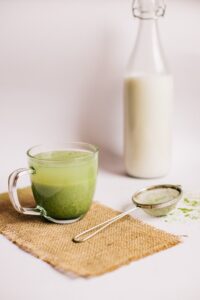3 POWERFUL SUNPROTECTIVE NUTRITENTS
High on my to-do list this month is to spend quality time in nature, and surely I am not the only one dreaming to book a holiday on the beach. The next thought that come to my mind is, how to avoid damage to my skin? Growing up, I remember my mum stressing me about protecting the skin from the sun. Obviously, as a teenager I couldn’t care less, but as I became an adult, I started to notice how some people had a greater number of wrinkles and age spots compared to others. The secret? Sun protection and good nutrition. Since then, I have been religious about the use of sun creams, but it was only when I started my career as nutritionist that I took it further.
The role of sunscreen
Sunscreen is the safest tool that we have to prevent skin cancer, slow down photoaging (wrinkles and dark spots) and avoid sunburn. UV rays (UVA=aging and UVB=burning) trigger white blood cell activity, that stimulate free radicals’ production and inflammatory compounds called prostaglandins. This process promotes an imbalance between free radicals and antioxidants, exacerbating oxidative stress in the body. This process increases DNA damage, inflammation, and decreases collagen’s synthesis. Collagen is a protein that acts as a glue for the skin, keeping it elastic and plump. When collagen levels get low, the skin can look saggy and dry. This is why we want to keep collagen levels as high as possible.
So, using sun creams is essential for skin health, but we can take it a step further with nutrition.

Sun protective nutrients
Foods cannot replace topical sunscreen, but they can be a great addition to it, particularly when consumed as part of a heathy diet. It appears that certain compounds in foods can increase the protection against UV rays, and they do so by providing antioxidants, which moderately fight oxidative stress, and by absorbing and dispersing part of UV rays, avoiding excessive damage to cells.
- The most common sun-protecting nutrients is lycopene, part of the carotenoid family, it is found in red coloured fruit and vegetables. Several small human studies show that consumption of lycopene-rich foods over the course of 10 to 12 weeks, can reduce skin redness and sunburn (erythema) caused by sunbathing. Another study used 40gr of tomato paste plus olive oil for 10 weeks resulted in 40% less severe sunburn. Common sources of lycopene are tomato, guava, watermelon, grapefruit, papaya, red peppers, purple cabbage and mango. You might also want to add a source of fat, along with lycopene-rich foods, because it can help to increase absorption. Need inspiration? Try a cool gazpacho with extra virgin olive oil or papaya chunks with nuts.
- Beta carotene is another skin partner when it comes to sun exposure. It is the precursor of vitamin A and it is found in
 orange/yellow fruit and vegetables. The beneficial effects of this nutrient are dependent on the length of consumption, so if you are preparing a holiday in the sun you need to start planning early. A minimum of 7 weeks is necessary to see any results, hence you can ripe the most sun-friendly benefits when following a diet rich in beta carotene foods long term. Common sources are sweet potatoes, carrots, butternut squash, pumpkin, apricots and dark leafy greens (like rocket, kale, spinach, chard, Bok choy and beetroot greens). Try making your salad more interesting by mixing lettuce with rocket, baby kale and spinach, or swap classic potatoes with sweet potatoes.
orange/yellow fruit and vegetables. The beneficial effects of this nutrient are dependent on the length of consumption, so if you are preparing a holiday in the sun you need to start planning early. A minimum of 7 weeks is necessary to see any results, hence you can ripe the most sun-friendly benefits when following a diet rich in beta carotene foods long term. Common sources are sweet potatoes, carrots, butternut squash, pumpkin, apricots and dark leafy greens (like rocket, kale, spinach, chard, Bok choy and beetroot greens). Try making your salad more interesting by mixing lettuce with rocket, baby kale and spinach, or swap classic potatoes with sweet potatoes. - EGCG is the notorious compound found in green tea and matcha tea. Over the past 20 years, there has been a lot of research investigating its role in lowering the negative effects of UV radiation by decreasing white blood cells activity and strengthening of the skin. EGCG seems to specifically offer protection against damage on certain skin cells (keratinocytes and Langerhans cells, a type of cell that gets rid of harmful organisms inside our body) and decreases the likelihood of sunburn by maintaining the skin barrier integrity. During the hottest months you can alternate coffee with cold matcha latte.
Do not reach for food supplements yet, firstly prioritise whole foods unless advised by your medical practitioner. Whole foods have much more than the mentioned compounds, they are a combination of vitamins, minerals, macronutrients and phytochemicals that work together to promote health.
Sun safe practices
If sunscreen and sun protective foods are essential to avoid sun damage, we can also follow lifestyle tips, particularly if you have a fair skin tone, prone to irritation. It is essential to stay in the shade during the hottest hours of the day (usually between 11am and 4pm, depending on which country you are living in), this is especially important to avoid sunburning and sunstrokes. The use of hats and appropriate clothing can also reduce the chances of getting sunburns. Light, loose fitting clothes can help you stay fresh and block some UV rays. Vulnerable individuals and people living in very hot countries, might also need to wear UPF (ultraviolet protection factor) clothing up to 50+. Sunglasses help to protect your eyes from irritation and burn, select a type that clearly state their protection against UV rays.
My advice is to combine more strategies, a mixture of SPF skincare, foods, and lifestyle tips can ensure higher protection allowing you to enjoy a safer summer with a glowing skin.
REFERENCES
Köpcke, W. and Krutmann, J. (2008), Protection from Sunburn with β‐Carotene—A Meta‐analysis†. Photochemistry and Photobiology, 84: 284-288. https://doi.org/10.1111/j.1751-1097.2007.00253.x.
Matta MK, Zusterzeel R, Pilli NR, et al. (2019). Effect of Sunscreen Application Under Maximal Use Conditions on Plasma Concentration of Sunscreen Active Ingredients: A Randomized Clinical Trial. JAMA. 321(21): pp.2082–2091. doi:10.1001/jama.2019.5586
NHS (2019). Sunscreen and sun safety. www.nhs.uk/live-well/healthy-body/sunscreen-and-sun-safety [Online].
Parrado, C. Philips, N. Gilaberte, Y. et al. (2018). Oral Photoprotection: Effective Agents and Potential Candidates. Frontiers in medicine, 5, pp.188. doi.org/10.3389/fmed.2018.00188.
Passeron, T. Bouillon, R. Callender, V. et al. (2019), Sunscreen photoprotection and vitamin D status. Br J Dermatol, 181: pp.916-931. doi.org/10.1111/bjd.17992.
Skin Cancer Foundation (2021). www.skincancer.org/blog/ask-the-expert-does-a-high-spf-protect-my-skin-better. [Online].
Stahl, W. Sies, H. (2012). β-Carotene and other carotenoids in protection from sunlight, The American Journal of Clinical Nutrition, 96, (5), pp.1179S–1184S, doi.org/10.3945/ajcn.112.034819.
Stahl, W. Heinrich, U. Aust, O. et al. (2005). Lycopene-rich products and dietary photoprotection. Photochemical and Photobiological Sciences, 5(2), pp.238-42. doi: 10.1039/b505312a. Epub 2005 Aug 12. PMID: 16465309.
Xu, Y., Zhu, J., Zhou, B., & Luo, D. (2012). Epigallocatechin-3-gallate decreases UVA-induced HPRT mutations in human skin fibroblasts accompanied by increased rates of senescence and apoptosis. Experimental and therapeutic medicine, 3(4), 625–630. https://doi.org/10.3892/etm.2012.466.








